



How CVG Took off
Under Candace McGraw




GROWING THE AIRPORT INTO AN ECONOMIC FORCE FOR THE










GROWING THE AIRPORT INTO AN ECONOMIC FORCE FOR THE

Powered by

In partnership with Medical Mutual, we are offering an expanded ChamberHealth® program to provide you – our members – with premium health insurance coverage while saving you money through group buying power. Through this partnership, we are now able to offer ChamberHealth insurance plans to businesses from 1 to 500 employees in the state of Ohio – an expansion of the program that was previously only available to companies from 2 to 99 employees.
*ADDITIONAL PLAN OPTIONS INCLUDE:
• Prescription drug coverage
• Wellness programs
• Identity theft resolution and remediation services are offered at no additional cost.

TRADITIONAL COPAY AND HIGH-DEDUCTIBLE PLANS WITH HSA
Through ChamberHealth, small businesses and sole proprietors – a first for the ChamberHealth program – can partake in a self-funded insurance plan. Being self-funded has many benefits, including:
• The ability to keep costs low since MEWAs are not subject to some of the Affordable Care Act’s (ACA) mandated benefits and taxes
• The cost of benefits reflects the unique health of the company and its employees, recognizing that a healthier team should create a better benefits cost outcome
• All benefit options are tied to Medical Mutual’s large network of doctors and hospitals, including TriHealth, the Christ Hospital Health Network, and Mercy Health



METRO DELIVERED:
7 24-hour routes, plus 24/7
Access Service
Better connections with 7 crosstown routes
Service to over 93,393 jobs
On-Demand Transit with MetroNOW!
Convenience with free WIFI and charging ports on buses, Transit app
Upgraded bus stops, and a New Transit Center
$300 million for improved roads, sidewalks, & bridges for Hamilton County
Driving towards the future with Bus Rapid Transit coming 2028
Ensuring mobility for all with $500,000 annually to low-income riders
THANKS TO YOU, METRO IS LEADING THE NATION IN POST-PANDEMIC RIDERSHIP RECOVERY!




The College of Creative Arts is where Miami’s students push the boundaries of traditional disciplines to explore new mediums and technology. With an Emerging Technology in Business and Design degree, students develop core skills in data strategy, programming, entrepreneurship, and communications. This transdisciplinary course of study opens a wealth of career opportunities while employers gain leading digital experts. Fostering innovation and creativity is at the core of our curriculum — and our mission.


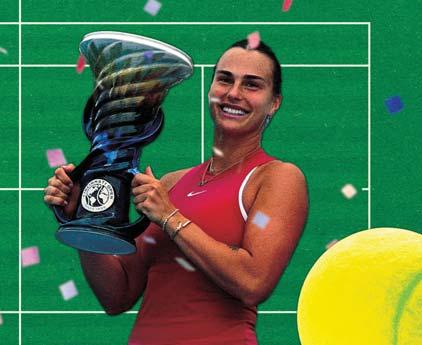

CENTER OF ATTENTION
Updates on construction projects at the Duke Energy Convention Center and the HQ hotel
12 MARKETING BEING HERE
The new Brand Cincy Hub helps companies recruit with one voice 14 SPORTS SMASHING TIME AGAIN IN MASON
The Cincinnati Opens continues its ascent in Beemok Capital’s second year of ownership
PEOPLE BUSINESS Kiki the Barber connects with Oxford neighbors thanks to a Storefront to the Forefront grant
A
08 BY THE NUMBERS
The annual State of the Region report shows how our job growth, export numbers, and GDP stack up against peer cities.

HOW CVG TOOK OFF UNDER CANDACE McGRAW

50 ASK ME ABOUT

Get to know Robie Suggs of Warsaw Federal Bank, Kevin Wright of Yard & Co., and Khaled Shammout of Metro/SORTA.
52 PHOTO ESSAY: HERE’S TO OKTOBERFEST ON THE DOWNTOWN RIVERFRONT!
Revelers certainly followed Oktoberfest Zinzinnati to its new location at Sawyer Point and Yeatman’s Cove, and we have the photos to prove it. Prost!
The airport CEO, who announced she’ll be retiring next year, has turned CVG into an economic power and a welcoming place for travelers. 32
START BY TALKING ABOUT MENTAL HEALTH
Mental health is a major workplace challenge for business leaders and employees, but new programs are providing help.
CAN CINCINNATI SUPPORT A NEW ARENA?
A new feasibility study analyzes the need for building a downtown arena to attract additional events and tourism dollars.
TASTE THE DIFFERENCE
Butler County’s superior water quality has made residents, businesses, and economic development teams happy.
his issue will land on your desk just after the lights go off at BLINK 2024. As I write this letter, we’re deep in final preparations and are so excited for you to experience what we’ve worked so hard to produce and curate. We believe BLINK is a cornerstone of our future city and that it drives every part of our economic growth strategy.
In this magazine, which we produce for our members and stakeholders four times a year, you’ll read about our State of the Region Report presented by First Financial Bank. And, like always, you’ll read about community leaders who are driving growth in our economy, population, and cultural vibrancy.

And finally, as you see on the cover, you’ll read an exit interview with one of the most consequential regional leaders in the last 15 years: Candace McGraw. Her steady leadership of the Cincinnati-Northern Kentucky International Airport has turned CVG into one of the most important drivers of growth. We’re now the 12th-busiest cargo airport hub in the world with a $9.3 billion economic impact in our region. There’s a new rental car hub, an upcoming terminal renovation, and dozens of new flights and carriers, including the direct flight to London on British Airways.
Candace’s steady leadership has made all of this happen. She built a tremendous team that’s focused on running a best-in-class airport that drives economic growth across our region. She is a connector.
If we were electing a Governor of the region, I’d vote for Candace. She has deep relationships throughout the region with business leaders and elected officials. She represents us globally through her service as chair of the World Governing Board of Airports Council International and helps expand our standing and our economy through her work.
She’s been the Board Chair of the Chamber for the past two years, and I’ve appreciated her counsel and strategic mind as we launched our plan. Fortunately for us, Candace will continue to be a leader in this region for many years to come. I hope you enjoy reading about her and her extraordinary years at CVG.
BRENDON CULL BCull@cincinnatichamber.com













MAJOR UPDATES IN THE CONVENTION DISTRICT TAKE CENTER STAGE DOWNTOWN
Get a jump on news about new branding and marketing tools for local businesses, the record-setting Cincinnati Open tennis tournament, and Ignite Philanthropy’s expansion to Charlotte. And catch up with an Oxford small business owner participating in this year’s Storefronts to the Forefront program.
The 2024 State of the Region report is a snapshot of how the 15-county Cincinnati region is growing and what opportunities and challenges lie ahead. Among peer cities, our real gross domestic product (GDP) is larger than one would expect for a region its size, due in large part to strong manufacturing and export bases, including aerospace and consumer goods. Cincinnati continues to have the highest regional GDP among our closest geographic peers, including Indianapolis, Columbus, Cleveland, and Pittsburgh.






Expanded multiple times since first opening in 1967, the Duke Energy Convention Center is undergoing a complete makeover that’s scheduled to take 18 months. 3CDC is leading the project with funding from the city of Cincinnati and Hamilton County.
The downtown convention center covered one square block in 1967 and featured 95,000 square feet of exhibition space, making it one of the largest meeting facilities in the U.S. Expansions in 1984 and 2006 increased capacity to 750,000 square feet.
Opened as the Cincinnati Convention-Exposition Center, the facility was renamed in 1987 for Albert B. Sabin, who is credited for developing an oral polio vaccine at Cincinnati Children’s. The name was changed to Cinergy Center in 2006, and then Duke Energy Convention Center.
Public bonds were issued to fund the center’s renovation, backed by future transient occupancy tax income from the city of Cincinnati and Hamilton County as well as direct capital contributions from both entities. The convention center and its new Elm Street Plaza are expected to reopen in January 2026.
3CDC is also managing construction of a new convention headquarters hotel across Fifth Street from the center. The 800room hotel will be developed by Atlanta-based Portman Holdings, with the brand name still to be announced. Construction is set to begin in the first quarter of 2025, with the hotel opening in early 2027.



—CARRIE BLACKMORE
What makes Cincinnati tick? What’s our brand? “It’s not a slogan or a logo or an arch or a statue or a river,” says Anastasia Mileham. “A brand is DNA. It’s what’s inside. It’s what endures after a statue is removed or an arch is torn down.”
As executive director of Cincinnati Experience (CX), Mileham’s job has been to communicate that feeling—the essence of Cincinnati—to the rest of the world. Figuring out the right messaging took years of focus groups, surveys, perception studies, and contributions from inside and outside the region, along with support and input from many regional partners.
Boiled down, Mileham says, the message is this: Cincinnati has heart, it has hustle, and it’s a desirable home. And now there is a free business-to-business toolbox, the Brand Cincy Hub, available to anyone wanting to convey that message.
“The factors that drive businesses, talent, and visitors to choose a city are increasingly aligned, and the marketing and branding should align too,” says Mileham. “Cities should be more closely coordinating their economic development and tourism branding and promotion, which is exactly what Brand Cincy aims to do.”
Anyone wanting to use the hub can create a log-in at BrandCincy.com to gain access to marketing and recruitment materials such as fact sheets, videos, photos, and social media guidance as well as downloadable materials like talent attraction brochures and retractable banners for job fairs and campus visits. There are downloadable visitor’s guides and itineraries to show recruits around the region. All assets can be incorporated directly into an organization’s or company’s own visuals and branding.
Procter & Gamble is a founding member of Cincinnati Experience and uses the hub, says
Bobbi Dillon, senior manager of state government relations.“We understand how to engage potential recruits on the value of being a P&G employee, and Brand Cincy provides us the tools to also capture the value of being in the Cincinnati community,” she says. “It allows us to address both the work and life components that so many are looking for today.”
Brand Cincy materials include handy QR codes that allow recruits to access digital resources on topics like Cincinnati’s arts and culture, food and drink, festivals and events, neighborhoods, and more, says Dillon. CX’s social media presence enhances the experience for job recruits, creating a special connection to Cincinnati and P&G.
Hub materials feature the entire region, Mileham says, including neighborhood fact sheets and links to videos about living all over, from Cincinnati’s many city neighborhoods to the northern Ohio suburbs and across state lines in Indiana or Kentucky. CX is currently working on adding materials aimed at executive level recruitment and attracting international companies.
“We’ve got so much going on in Cincinnati, whether you’re a sports fan or you’re into arts and culture or outdoors life with the rivers and the biking trails,” says Mileham. “On the business side, the diversity and industry that exists in our region is what’s helped us thrive over the years.”









Butler Tech Adult Career Programs
Healthcare:

New: Registered Nursing (LPN to RN Bridge)
Public Safety:
Industrial Technology:
Now Enrolling! Get started today at



When Coco Gauff and Novak Djokovic raised their championship trophies at the 2023 Western & Southern Open tennis tournament at the Lindner Family Tennis Center, nobody in the stands, on the court, or in the administration offices knew if the Mason-based event would return this year.
Beemok Capital, a Charleston, South Carolina, company owned by Ben Navarro, bought the rights to the tournament in 2022, and it was reported that Charlotte would likely be its new home. But six weeks after the final matches, a video featuring Djokovic and Gauff delivered the decision: The Cincinnati Open, the original name of the event that traces its roots to the Avondale Athletic Club in 1899, would stay in Warren County for another 25 years, while more than $260 million in improvements (roughly split between Beemok and money raised in Ohio) would overhaul the facility.
The payoff was immediate. This year’s tournament drew more than 205,000 fans, a record for the single-week event, that crowned winners Aryna Sabalenka and Jannik Sinner in its 125th anniversary celebration. Thirteen of the week’s
16 sessions sold out, with Opening Day hosting 14,852 people, a single-session record. Next year’s competition will expand to two weeks (August 5-18, 2025) with the number of players in the men’s and women’s draws increasing from 56 to 96.
Beemok didn’t wait to make some of the planned changes. All of the nearly 12,000 Center Court seats were replaced before the 2024 matches. The day before competition began, organizers inaugurated Community Day that featured Grand Slam champions Andre Agassi and Steffi Graf. That event drew 7,000 and raised $200,000 for charities.
Coming improvements include a 2,000-seat sunken stadium that will become the fourth largest of the Lindner Center’s five stadium courts. A 56,000-square-foot players’ facility and another building that will house golf operations for the Grizzly Course are scheduled to be finished by the end of 2024 so the interior
work can be wrapped up by next August—as will a tennis pro shop and six tennis, six pickleball, and two padel (platform-like tennis) courts that will be open to the public.
Cindy Starr covered tennis for The Enquirer before moving to USA Today, where she covered Wimbledon, the U.S. Open, Davis Cup finals, and other tournaments for years. When she began writing about the hometown event, it was played on courts at Coney Island. Attending this year’s tournament as a fan, she’s a true believer in its potential.
This year’s event drew more than 205,000 fans, a Cincinnati Open record.
“The Cincinnati Open is not the U.S. Open, but it’s almost the U.S. Open,” she says. “If you blindfolded a group of people, flew them to Cincinnati from out of town and told them they were at the U.S. Open, they would probably believe you.”
And more than likely thank you for bringing them to Mason, Ohio. In fact, for the second year in a row, both the men’s and women’s winners in Cincinnati went on to take titles at the U.S. Open.




Kiki the Barber connects with Oxford neighbors thanks to a Storefronts to the Forefront grant.
–SARAH M. MULLINS

In the heart of Oxford, Ohio, Kiki the Barber is more than just a place to get a haircut—it’s a sanctuary for those seeking a moment of peace, a place to relax, and a genuine connection. Owner Juiquetta Harmon makes sure to say that she doesn’t just cut hair. She hopes to bring confidence to kids on picture day or a safe place for kids and adults alike to read in the on-site lending library.
“I love being able to connect with the people who have been helping me the last couple years,” she says. “I enjoy listening to the stories, listening to the kids, watching them grow up from their first haircut and through college. It’s not work for me.”
Harmon’s barber story started more than two decades ago when her father was recovering from a sudden medical scare. She says her dad and son were her first hair models during that time, giving her feedback and teaching her patience and kindness.
Fast forward to today, and Harmon says the barbershop is more than just a business. She aims for it to be a bright spot in the community where people with and without an appointment can grab a book, use the wifi to work, or stop to chat with her between appointments.
Her passion for the community is why the Storefronts to the Forefront program supports local businesses like Kiki the Barber with $5,000 grants. Harmon plans to use the funds to replace her exterior sign, improve the building facade, and eventually open employment opportunities for aspiring barbers.
“Receiving this grant is like a pat on the shoulder,” she says. “I don’t know how to describe what it’s like to be thankful and grateful. I’m in the business of people, not in the business of hair. The amount of love and compassion people need is tangible and authentic. They need to know they belong, and I get to do that every day.”
Now in its third year as a partnership among Duke Energy, Huntington National Bank, and the Cincinnati Regional Chamber, Storefronts to the Forefront helps small businesses improve facilities, buy new equipment, and support marketing efforts and expansion. Stronger small businesses ultimately foster vibrant communities across the region’s business districts. Other recipients of this year’s grants include Better Blend in Ft. Mitchell, The Cone in West Chester, Ferrari Brothers Restaurant Group in Camp Washington, Jet Age Records in Newport, Market Street Grille in Harrison, and Peter Gregory Florist in Blue Ash.
Storefronts to the Forefront distributed grants in 2023 in Clifton, Goshen, Mt. Washington, Oakley, and Dayton, Kentucky. Grants in 2022 supported business districts in East Price Hill, Loveland, Milford, Madisonville, New Richmond, Norwood, Reading, and Walnut Hills as well as Bellevue, Ft. Thomas, and Ludlow, Kentucky.
Watch videos featuring all Storefronts to the Forefront neighborhoods and find out how you can better support small businesses at storefrontstotheforefront.com. You can also support them on Small Business Saturday November 30.
























































Just over a decade in business, Ignite Philanthropy expands its successful consultancy model to Charlotte.
—ELIZABETH MILLER WOOD
While it’s not uncommon for consulting firms to start out with one or two anchor clients, few can claim the splashy debut that launched Ignite Philanthropy in 2013: the $83-million revitalization of Music Hall. And while the company was a new kid on the philanthropic block, founder Scott Provancher was anything but. He’d been president of the Arts & Science Council in Charlotte, North Carolina, after managing fundraising for the Fine Arts Fund (now ArtsWave) and running the Louisville Symphony.
Provancher’s brainchild began as Lewis & Clark Co., a fundraising and advisory firm for large-scale nonprofit initiatives. Its wheelhouse expanded into private foundation management after acquiring Ignite Philanthropy Advisors in 2016 and assuming the Ignite name.
On the fundraising side, Ignite Philanthropy caters to nonprofits embarking on “big idea” fundraising campaigns, such as those for Women Helping Women and Freestore Foodbank. On the private foundation side, the firm advises clients on big-picture donation strategies. “We pulled that full range of services under one roof,” says Provancher.
In 2018, Teresa Hoelle, Provancher’s wife, left her role as chief marketing officer at United Way of Greater Cincinnati to join Ignite Philanthropy as co-owner and lead the firm’s communication and talent management divisions.

They acquired data analytics firm Blue Fox in 2022, adding the power of donor data to its arsenal. Using public records, Ignite Philanthropy can identify—and thus efficiently target—what Provancher calls “receptive audiences” who are most likely to support their client’s cause. For the firm’s foundation clients, data analytics help broaden the scope of donation recipients aligning with causes the foundation is passionate about.
“It’s about increasing the flywheel of philanthropic power,” says Provancher. “I think there’s a lot of money sitting on the sidelines that could be put into play if the right opportunities are communicated to the right audiences.”
Between 2020 and 2023, Ignite Philanthropy’s revenue more than doubled from $2.2 million to $4.7 million and its team grew from 12 full-time employees to 31 today. In 2023 alone, the firm raised $70 million for nonprofit clients and helped foundations distribute $16 million to strategically chosen initiatives.
The burgeoning firm year evolved even more this year. Tara Noland was promoted to president and co-owner, bringing years of experience as founding executive director of the GreenLight Fund and demarking Ignite as a majority woman-owned business. Ignite also launched its first satellite venture: a boots-on-the-ground team in Charlotte, seeking to replicate the model and success of the firm’s operations in Cincinnati in a growing city Provancher is familiar with.

That said, he says it will take time to understand the unique players, styles, and even personalities of Charlotte’s current philanthropic culture. It will be challenging to resist the temptation to expand too aggressively, he says, but the “go slow to go fast” strategy has already served the firm well and preludes a hopeful future.








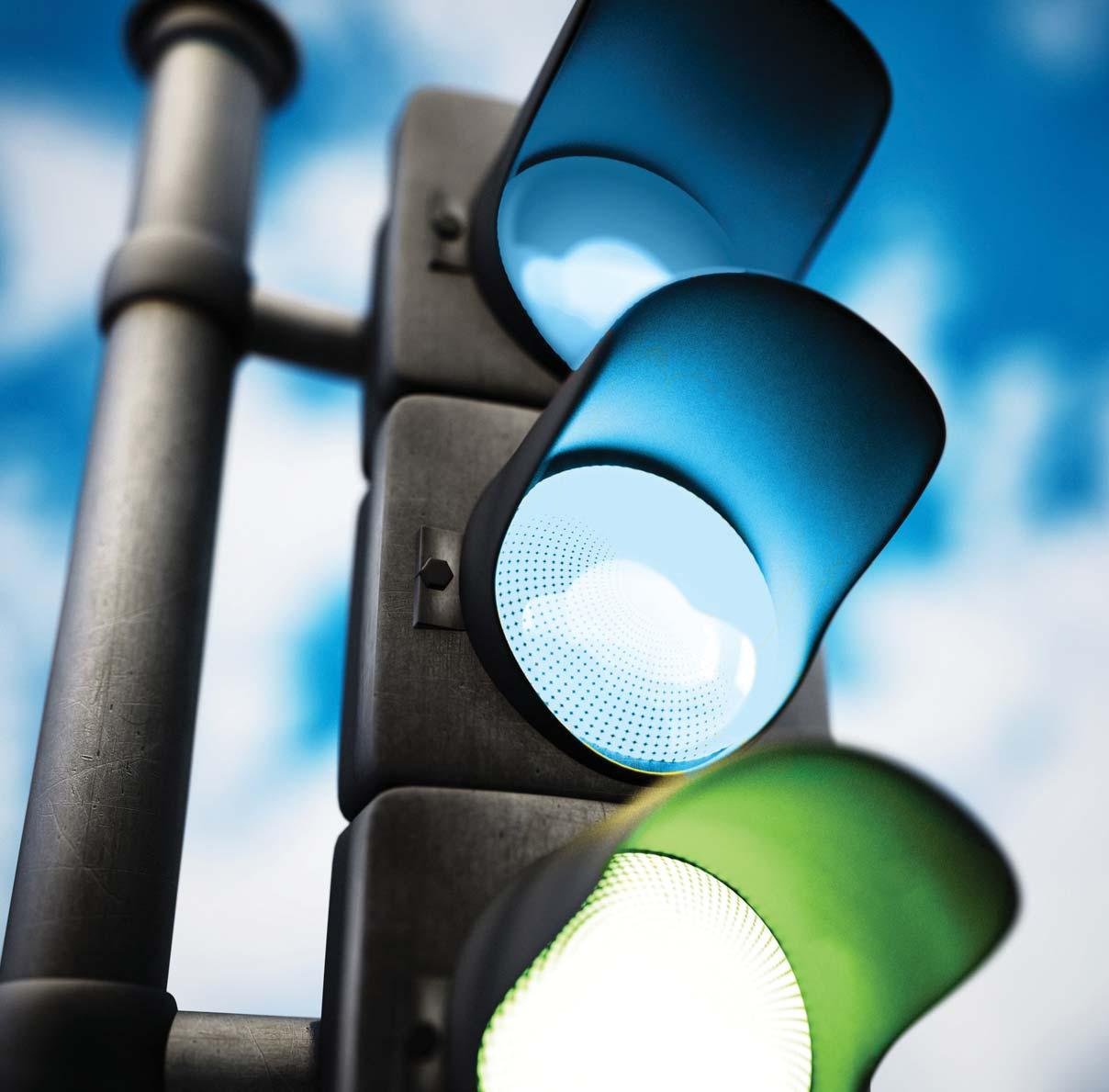





BY FOCUSING ON CARGO OPERATIONS, RECRUITING LOW-COST AIRLINES, AND DEVELOPING 7,700 ACRES OF LAND, M c GRAW TURNED CVG INTO AN ECONOMIC POWER AND A WELCOMING PLACE FOR TRAVELERS.
BY DAVID HOLTHAUS

When Candace McGraw was named chief executive of CVG in 2011, the region’s primary airport was in a tumultuous state. Her predecessor had abruptly resigned after only two years on the job. Delta Air Lines’ near-monopoly on terminal gates had resulted in some of the highest airfares in the country, and Cincinnatians would often travel 100 miles or so to find cheaper fares at another airport.
Delta’s merger with Northwest resulted in closure of the airline’s expansive hub here and a steep drop in the number of passengers utilizing CVG. But its years of dominance meant other carriers had been crowded out and no low-cost carriers were operating out of Cincinnati. Thirteen years later, multiple lowcost carriers are available, the airport has become a major cargo hub, and it helps drive the region’s economy with an annual economic impact of
more than $9 billion.
Earlier this year, McGraw announced she plans to retire in June 2025. In addition to her leadership role at CVG, she is chair of the Cincinnati Regional Chamber’s board, chair of the Kentucky Chamber of Commerce, and chair of the Airports Council International’s World Governing Board. Her leadership will be missed at each of these organizations and across the region as well.
McGraw describes the challenges she faced in leading the airport’s turnaround and what’s next for her and for CVG.
It was stabilization. I think about the chunks of time in my role at the airport: The first five years was stop the bleeding, the next five years was stabilize the patient and get them healthy, and this last five years was OK, we’re running a marathon now, we’re in good shape, we’re more of a contender.
CVG WAS ONCE KNOWN FOR HAVING THE HIGHEST AIRFARES IN THE COUNTRY. HOW DID THAT GET TURNED AROUND?
If you recall back then, we had one primary carrier. And if you recall the lay of the airport, we had three terminals. Terminal 3 was all Delta. At Terminal 2, you only had eight gates for every other carrier. We had no low-cost airlines.
The first order of business was giving those existing carriers a place to grow, and then attracting new carriers. Once you had carrier diversity, you knew you were going to get lower prices because competition would ensure that you ended up with lower airfares. And now about 30 percent of our travel is done through low-cost carriers. It brings some price discipline from the carriers.
We didn’t have facilities in which
they could even operate because of that old system with those eight gates in Terminal 2. They didn’t have a place from which they could operate. We rightsized the facilities so we could attract new carriers. And then we had to convince a carrier. In our case, it was Frontier who came in and were the first low-cost carrier at CVG.
It was a huge win. They put in six flights a week to Denver, and we celebrated that mightily and trumpeted it very loudly, because we knew if they could be successful it would be a proof point for other carriers to be able to come here.
Delta and Northwest merged back in the mid-2000s, around the same time U.S. Air and American merged. There was consolidation in the industry. Delta made the decision to concentrate more of its business in Detroit and Atlanta based on all the investments they had around the country between the two airlines at the time. And, fortuitously, that opened up facilities for other carriers to move in.
Some people say they miss the connectivity we used to have as a Delta hub. But we’re much more financially stable and sustainable now. And this community has much better air service than it did, because back then 85 to 90 percent of our passenger base was connecting passengers. So while we had millions more passengers than we do today, 90 percent of them were not our friends, family, and neighbors traveling out of here. They were connecting through. So now we have air service that meets local needs in terms of business and leisure travel.

Candace McGraw has developed positive working relationships with Amazon (hub groundbreaking with Jeff Bezos in hard hat, opposite page), British Airways (left), DHL, and a number of low-cost airlines since becoming CEO in 2011.

Well, it’s Basic Business 101: What do you have, and how do you utilize and exploit it the best way possible? We said we had a great passenger base here and started to dive into the business travel analysis: Where are passengers coming from? Where are they going? What air service do they need? We came up with the business case around that and then went out and made that case, knocked on the airlines’ doors and said, You know, we
think your airline would be successful in CVG if you served these particular markets. Just doing that roadshow.
That was first. Next was looking at the great cargo business we had with DHL. They’d been here, moved up to Wilmington, and then came back here at the end of 2009. We said, How can we make you more successful? How can we work with you hand-in-glove to make sure you can grow here? CVG is now DHL’s second-largest operation in the world, behind only Leipzig, Germany, and some days we move more cargo than their No. 1 international operation.
Third, we looked at the land available to us that was sitting dormant.
We did a land-use development plan for what we should develop, where, and how. That’s ultimately been a huge success for us, because right now we have a variety of land tenants paying our bills.
The airport was very land rich. We have 7,700 acres here, and we had a good bit of it close in that could be developed—the 650 acres that Amazon is operating on now, for example, was prime for aeronautical development. We also have acreage that’s farther afield, such as the 170-plus acres between here and Florence that we developed for a GE manufacturing site, a Wayfair site, and some other diverse tenants that didn’t necessarily need be located next to the airfield.
We looked at what sort of tenants could be there, then went out and recruited them. We consistently looked at how to diversify the commercial carriers and the cargo business, because we didn’t want to create another 800-pound gorilla like Delta that was going to dictate how we did business.
HUB WAS THE BIGGEST ECONOMIC DEVELOPMENT
EVENT IN THIS REGION IN A LONG TIME. HOW DID YOU CLOSE THE DEAL?
We were out peddling our land, talking to lots of people about what we had available for development. A consultant approached us to say they were working with a tenant that needed a large stretch of land and that needed to move quickly—except the consultant seemed to be moving slowly. I said, Well, if you need
to move quickly, then you need to step aside and just bring your client in here and we’ll work out a deal. We sat down with Amazon and just hammered out a deal in fairly short order. We really negotiated in earnest starting in October 2016, and we signed the deal and had it approved by our board in January 2017.
I asked the Amazon people what made them close the deal here, and they said we have well-maintained runway infrastructure already in place, well-maintained highway infrastructure in place, a workforce that has a deep history in aviation, and we could move at the speed of business. Ever since that time, I’ve used those as the touchpoints of what makes a deal im-
portant: infrastructure, having trained people, and then being able to move quickly and get decisions made.
(AMAZON, DHL, AND OTHERS)
It means we have a really good base of operations that will keep CVG fiscally strong, which helps with commercial air service. The more cargo operations we have landing here, the lower the landing fees we charge our commercial operators. It’s a great synergy be-
tween cargo and passenger carriers in terms of making sure our airport fees are competitive.
What it means for the broader community is, of course, jobs. It also positions this region to attract, retain, and grow different jobs, manufacturers, and business sectors. If I was a widget maker and could locate anywhere in the world, I’m going to locate near here, because I want to be able to get my widget to market with redundancy every day. If you locate somewhere in proximity to CVG, you can bring your widget out here at 10 p.m. and have it the other side of the world first thing in the morning. And you have redundancy, because you can use either cargo shipper.
NEW REVENUE, NEW UPGRADES Cargo capacity expansion for both DHL and Amazon (opposite page) helped fund passenger improvements at CVG, including the new rental car hub (below).

THE AIRPORT DOCTOR
Candace McGraw thinks of her time as CEO in three fiveyear periods: The first was stopping the bleeding, the next was getting the patient healthy, and the last few years has been running a marathon.
CLUTCH CARGO
CVG’s recruitment of Amazon Air and DHL as major cargo shipping hubs has benefitted business and leisure travelers by allowing CVG to lower landing fees for commercial airlines, which led to the airport finally bringing in low-cost carriers.
IN THE WORKS
In McGraw’s last eight months as CVG leader, she’s overseeing a terminal modernization project, which includes a new baggage-handling system, and further land development by aviation companies.
THE EMERGENCE OF COVID WAS A CRISIS FOR AIR TRAVEL. HOW DID YOU COPE WITH THAT?
It was horrific in terms of waking up one morning and 85 to 95 percent of your commercial traffic had been altered. Thankfully, we had already diversified our business, so we had a playbook on how to get out of the difficult situation because our team had already been through it. As horrible as the pandemic was, the airport already had a diversification strategy. We had cargo that did really well, and we had land development with diversified tenants paying rent. So we tightened our belt, and thankfully we didn’t have to lay off anyone.
HOW HAS TRAVEL CHANGED IN THE TIME YOU’VE BEEN AT THE AIRPORT, BOTH LEISURE AND BUSINESS?
Business travel looks different now than it did pre-pandemic, because you have meeting substitution methods that have become quite common and you don’t have to make as many business trips as you once did. But there’s a term in the industry called “bleisure travel,” a blend of business and leisure travel. Now people are traveling for work and tacking on a few days extra if they can. That’s sort of a new twist in the industry.
CVG HAS DEVELOPED A REPUTATION FOR INNOVATION. WHAT HAS THAT MEANT FOR THE AIRPORT?
We have a marvelously supportive
board that gives us the license to try things and figure out what the next thing is that might be important. We have all our passengers who travel through here, so it’s a great living lab for companies that want to come here and innovate.
In terms of leaning into what’s next in aviation, we’ve been working a lot in the advanced air mobility sector—think Jetsons, flying cars, what’s coming next, and how that evolves. Think about how Cincinnati became an important city in the first place—it was our location on the river and what that river traffic meant. And then we grew with the advent of the Delta hub here, and that helped the city attract and retain business and grow. So now we’re trying to think about the next disruption and how advanced air mobility will impact travel and the aviation industry. We’re dipping our toes into it.
YOU’VE BEEN ACTIVE IN THE COMMUNITY THROUGH SERVICE ON BOARDS AND IN OTHER ORGANIZATIONS. WHAT DOES YOUR ROLE AS AIRPORT CEO MEAN FOR THE COMMUNITY?
I think it’s important to be at those tables and have conversations with people about what helps their businesses thrive and grow. I’m wired to participate and engage, and I think we’re all better if we can lean in and develop each other’s strengths. I like to say we’re Zip code agnostic, and I try to keep a foot on both sides of the river because we serve everyone across the region.
I have the privilege of being chair of the World Governing Board As-


sociation, which provides CVG with global recognition. That’s important, because as I sit at that table I get to tell the story of our region and what’s going on here, which literally put us on the map for people from Bahrain, Singapore, or you name the region of the world who would have otherwise not know about the Cincinnati and Northern Kentucky area.
YOU STILL HAVE EIGHT MONTHS BEFORE YOU OFFICIALLY RETIRE, HOW IS THE SEARCH FOR A SUCCESSOR GOING?
The board is conducting a search right now. They’ll name my successor probably late fall, I assume, with the goal of having that person be in this seat early next year. Then we’ll work through a transition plan—whatever they might need or however that might look— and I’ll officially be out the door here
as of June 30.
One of our projects is called Hanger Row, which is a development of several hundred acres for which the state of Kentucky invested $20 million last year. We’re doing some environmental studies and site prep work now. It’s an area that can support probably three or four more hangars along with maintenance repair shops, paint shops, avionics, and maybe even aircraft manufacturing.
Another project is a global logistics park for non-express cargo. Those are the large shipping items that come through, and right now that’s only about 5 percent of our business. We’ve signed a tenant there, and they’re in the process of building a facility. We’ve already done all the ramp work for it. We’re also in the midst of our
terminal modernization program. We’ll be doing a whole facelift and renovation throughout the terminal. Our folks do a great job of making it look great and fresh, but it hasn’t gone through a major renovation since it was first built in the 1990s. That will be a several hundred-million-dollar project, including a $200-million baggage-handling system that’s already under construction.
WHEN YOU RETIRE, YOU’RE PROBABLY NOT JUST GOING TO RIDE OFF INTO THE SUNSET. WHAT ARE YOU GOING TO DO?
Well, my husband and I will stay here. Our family’s here. The first order business will be to do some personal travel. I’m looking at some different things. I just want to enjoy the next phase while I’m young enough and healthy enough to lean into something fun.
Airlines like Allegiant, Alaska, Breeze, Frontier, and Southwest couldn’t afford landing fees or find gates when Cincinnati was a Delta hub. Their presence now makes CVG one of the more affordable U.S. airports.
BY SARAH M. MULLINS
In a world increasingly focused on productivity and bottom lines, the mental health of employees and their loved ones has emerged as a critical concern in the workplace. Businesses continue to grapple with the challenges of a post-pandemic landscape, and the need for accessible and effective mental health support has never been more urgent.
According to the Community Health Status Survey from Interact for Health in 2022, as many as 17 percent of individuals in the Cincinnati region reported frequent mental distress, which is defined as experiencing 14 or more mentally unhealthy days in a month. The survey also illuminated disparities among vulnerable populations: LGBTQ+ individuals reported the highest rates of distress

at 42 percent, followed by those living in poverty (31 percent), young adults (25 percent), and rural residents (23 percent).
To address these pressing challenges, Interact for Health, under the leadership of public health advocate Kate Schroder, is monitoring and measuring mental health challenges for people of all ages, as well as developing additional awareness and support programs.
Tier1 Performance, the Covington-based consulting firm, is one of the leading private businesses that’s embraced transparency and support for employees’ mental health. The company’s Start the Conversation program launched with a survey that revealed 94 percent of its workforce said they or one of their loved ones struggled with mental health; twothirds of program participants reported later that they spoke with someone about mental health for the first time thanks to information presented in the program. Today Tier1 offers its employee program to other companies at no cost.
SCHRODER IS A CINCINnati native and ran as a candidate for Congress in Ohio’s 1st District in 2020. Her platform included expanding access to affordable health care and economic mobility, and her experiences before and after underscore her expertise in health fields.
While working at The Health Collaborative, Schroder oversaw a regional effort to address disparities in vaccination rates. As vice president at the Clinton Health Access Initiative, she helped reduce drug prices and increased the number of children receiving proper medical treatment in India, Kenya, Nigeria, and Uganda.
Now president and CEO of Interact for Health, she’s aligned her health equity experience with the nonprofit organization’s mission that every person deserves the opportunity to live his or her healthiest life. That includes combating economic injustice, systemic racism, and other experiences by vulnerable populations.
The Interact for Health team went through a strategic planning process a year and a half ago, conducting more than 100 one-on-one conversations to hear the needs and issues faced by individuals in the community. Schroder says that mental health was a recurring theme in those discussions. In response, the organization launched a youth mental health initiative in partnership with other funders and community partners.
“One silver lining to the pandemic is that people are much more comfortable talking about mental health now and it’s becoming much more of a mainstream topic,” says Schroder. “This is especially the case with youth. They’re leading us in this space by talking about their feelings and their mental health every day. Some generations have grown up with more shame around mental health, and that’s just not the case with our younger generations.”
She’s encouraged that young people are breaking down these barriers to talk about mental health. “We aren’t going to be able to make progress unless we’re talking about what the needs are and addressing the needs,” says Schroder. “The first step is acknowledging, sharing, and supporting each other.”
Interact for Health is working to bring this practice to its work in two ways: Supporting youth mental health
and supporting its own staff. The organization hosted an internal suicide prevention training called Question, Persuade, Refer (QPR) in order to show how to respond and show up for friends and family going through challenging times. It also provided insight into how to be a voice for change while raising awareness and destigmatizing mental health in the community.
“We see a role in being a voice for change and helping to raise awareness and destigmatize mental health in our community,” says Schroder. “Talking
“ONE SILVER LINING TO THE PANDEMIC IS THAT PEOPLE ARE MUCH MORE COMFORTABLE TALKING ABOUT MENTAL HEALTH NOW, ESPECIALLY OUR YOUTH,” SAYS KATE SCHRODER.
about it, helping to make sure resources are accessible to parents and families, and to know where and how to access support.”
Access is a consistent theme and barrier that individuals face in their mental health journey, especially access to safe spaces for youth in the community. Most of what young people talked about in their discovery conversations was about not feeling heard or understood, a sense of safety, and connectedness with community, says Schroder. These learnings led to asking the question: How do
Interact for Health CEO Kate Schroder has realigned priorities based on the community’s mental health needs.

we learn to better listen and support youth and identify safe spaces in our community?
In response, Interact for Health is helping fund a number of organizations in the mental health space and works with other organizations to increase the youth voice in the development of mental health programs and services, particularly on the prevention side.
Similar to physical health—which can range from optimal wellness to severe illness—mental health presents along a spectrum, from thriving well-being to debilitating mental health conditions. Unlike physical health, though, mental health prevention is often overlooked. “We all know the benefit of preventative care,” says Schroder. “I’m a parent of two young kids, and they get two preventative dental visits a year and one primary care check a year. We don’t have that same benefit in mental health care, and that’s a real challenge.”
Individuals usually have to wait for a mental health issue to bubble up and become advanced or severe before medical benefits will cover care, which generally costs more in the long run.
Schroder sees policy opportunities for mitigating and supporting the treatment of mental health like physical health is treated. The pandemic unveiled mental health challenges that were already there, but it also escalated others.
“I think we’re entering a new era where there’s a lot more willingness to talk about mental health than there has ever been before, and I’m excited about that opportunity,” she says.
“Let’s get curious as employers, as parents, as colleagues, about how we can better show up in this space. The ball is in our court as a community, about what are we going to do and how we’re going to respond. I’m excited about how Cincinnati is showing up for each other.”
According to Interact for Health,
there’s a 26-year gap between some Cincinnati neighborhoods in terms of life expectancy. The organization evaluated quality of life factors driving these differences, finding that only 20 percent is driven by an individual’s healthcare decisions. The other 80 percent is impacted by the conditions in which they live, such as access to green space, access to education, employer relationships, safety in
MENTAL HEALTH PRESENTS ALONG A SPECTRUM JUST LIKE PHYSICAL HEALTH, BUT MENTAL HEALTH PREVENTION IS OFTEN OVERLOOKED.
their community, access to food, and transportation options.
Red Bike is an example of Interact for Health’s commitment to addressing health equity and improving health conditions across the region. Their sponsorship helps fund the bike-sharing program, and Schroder notes that the “Go” program offering subsidized or free bike-sharing services to lower-income individuals has one of the highest usage rates in the U.S.
The Red Bike program aligns with Interact for Health’s focus on addressing the broader conditions that influence health outcomes and helps encourage physical exercise, but they’re also available for those that need to get to a job, the library, or school.
HEALTH IS the cornerstone of well-being, but when something is adrift there can be implications in the workplace—from low performance to culture-diminishing effects and retention challenges. According to Mental Health for America, more than 28 million individuals are experiencing a mental illness symptom that goes untreated. Of those with a mental illness who did not receive treatment in the past year, 27 percent indicated that they’d experienced serious psychological distress in the past month. Survey respondents who indicated they’d sought treatment faced barriers to getting the help they needed, with cost of care as a significant barrier.
In response, Tier1 Performance has implemented mental health support and created an open culture around mental health for its own employees. The program, Start the Conversation, has been so successful that company leaders are now offering it pro-bono to help other local
Interact for Health recently released a comprehensive report outlining health disparities across the region and detailing steps the organization is taking to support closing those gaps. There’s a difference of 26 years in life expectancy between some Cincinnati neighborhoods, for instance. These disparities are caused by a variety of factors, some of which Interact for Health and other organizations are working to improve so citizens can live healthier lives.
Seven key themes guide Interact for Health as they measure, monitor, and impact the progress being made: humane housing, meaningful work and wealth, basic need for health and safety, belonging and civic muscle, lifelong learning, reliable transportation, and thriving natural world. Among the causes that impact these themes, Interact for Health is focusing on ways to combat economic injustice, systemic racism, and other forms of marginalization. Changing these systems and improving community conditions are lofty goals, but area organizations are making positive strides. Interact for Health has been highlighting some concrete steps taken in recent years.
THE CITY OF CINCINNATI PASSED AN ORDINANCE IN 2023 THAT PROVIDES LEGAL AID AND ASSISTANCE TO RENTERS FACING EVICTION. The program has helped prevent families from losing their homes and has gained momentum towards expansion plans.
A NORTHERN KENTUCKY AREA DEVELOPMENT DISTRICT STUDY IDENTIFIED A DEFICIT IN HOUSING, PARTICULARLY AFFORDABLE OPTIONS FOR FAMILIES Local stakeholders are actively working to develop innovative solutions to solve the housing shortage.
MAMA CERTIFIED IS A COLLECTIVE LED BY CRADLE CINCINNATI, QUEENS VILLAGE, AND THE HEALTH COLLABORATIVE. The initiative aims to reduce racial health disparities in mothers and infant mortality by improving systemic racism in healthcare.
THE CITY OF DAYTON, KENTUCKY PASSED A FAIRNESS ORDINANCE IN 2019 TO PREVENT DISCRIMINATION AGAINST LGBTQ+ INDIVIDUALS IN EMPLOYMENT, HOUSING, AND PUBLIC ACCOMMODATIONS Dayton was the 12th community in Kentucky to have this type of ordinance, and a dozen more cities have followed its lead.
IN THE SPIRIT OF BUILDING COMMUNITY, THE FINNEYTOWN LOCAL SCHOOL DISTRICT IMPLEMENTED SEVERAL INITIATIVES TO HELP FOSTER A SENSE OF BELONGING AMONG STUDENTS. The initiatives were co-designed by students and district leadership and led to increased student engagement, leadership skills, and a stronger sense of community.
THE COMMUNITY-BASED ORGANIZATION FOUND VILLAGE PROVIDES SUPPORT AND MENTORSHIP TO YOUNG PEOPLE WHO HAVE BEEN INVOLVED IN FOSTER CARE OR THE JUVENILE JUSTICE SYSTEM. The organization aims to break the cycle of trauma and help young people thrive.
CITIZENS ORGANIZED IN ORDER TO MOVE CINCINNATI POLICE DEPARTMENT’S GUN RANGE FROM LINCOLN HEIGHTS. The Heights Movement community organization cited noise pollution and general disruption in its petition to move the gun range, and the Hamilton County Commission agreed to move it by 2026.
MIDDLETOWN CONNECT IS A COMMUNITY ORGANIZATION THAT HELPED INCREASE RESIDENT ENGAGEMENT AND IMPROVED THE QUALITY OF LIFE IN THE CITY. Conversations led to improvements that impact everyday lives in Middletown, including community trash clean-ups, playgrounds, a community garden, and support for criminal record expungement. —S.M.M.
AWARENESS OF MENTAL HEALTH
According to a community survey conducted by Interact for Health in 2022, as many as 17 percent of individuals in the Cincinnati region reported frequent mental distress, which is defined as experiencing 14 or more mentally unhealthy days in a month.
WILLING TO TALK
Interact for Health
CEO Kate Schroder says we’re entering a new era of people, especially young adults, willing to talk about mental health. “Let’s get curious as employers, as parents, as colleagues, about how we can better show up in this space,” she says.
HELP WITH HELP
Tier1 Performance had such success with its Start the Conversation employee program that it now offers mental health support materials to companies around the region free of charge. More than 20 have implemented the program in their own organizations.
businesses implement the program in their workplaces.
Covington-based Tier1 helps organizations support and improve performance by building better workplaces, culture, and strong teams, with a portfolio of clients including Procter & Gamble, McDonald’s, and Macy’s. In their work revolving around a client’s workforce, company co-founders Greg Harmeyer, Kevin Moore, and Normand Desmarais realized that mental health issues impacted everyone in all places and phases of life but knew the topic was being avoided.
In 2015, the three decided to work toward destigmatizing mental health by assembling a group of employees and partnering with Lindner Center of HOPE in order to understand mental health challenges they and their loved ones faced and how they might tackle the challenges as a company. “We had a very healthy culture at the time, but the initial survey results opened up this whole discussion around mental health inside our own organization and normalized it,” says Harmeyer.
The Start the Conversation program followed a daily schedule of telling stories, videos, basic education, exercises, and reflections about things that individuals and their families have been through, plus tools and tips on how to have conversations with other people.
After the pilot program wrapped up, Tier1 deployed a second survey to evaluate how it was received. Sixty-eight percent of employees revealed that they talked to someone about mental health for the first time, 16 percent reported that they were unsure about how to talk to their children about mental illness (down from 38 percent before the program), and
74 percent shared that they talked to their child about mental illness after the program.
Beyond the culture-building benefits around mental health, Tier1 realized the program’s success and took further action to support employees. The company implemented an employee assistance program (EAP), which provides free and unlimited telehealth counseling and up to six free sessions of in-person counseling for the employee and household members. There’s also a stipend for mental healthcare costs outside of traditional coverage and a flexible work environment for employees to get the support they need.
SUPPORTING EMPLOYEES’ MENTAL HEALTH “HELPS THEM REALIZE THEY’RE NOT ALONE AND THAT THERE’S HOPE WITH WHATEVER THEY’RE DEALING WITH,” SAYS GREG HARMEYER.
“I can’t say strongly enough how important it is for leaders to just find a way to tell their story, because everybody has a story,” says Harmeyer. “I’ve found that over the past nine years of talking about this, finding a way to share stories inside an organization is so powerful. It’s something leaders can do to influence other people, to help them realize they’re not alone
and that there’s hope with whatever they’re dealing with.”
Tier1 took the successful internal program and launched it free of charge to other businesses seeking mental health support in the workplace. Senior Manager and Director of Healthy Cultures Meg Switala leads the program. “This is a fourweek journey that’s designed to just start the conversation,” she says. “We ask about how you continue to nor-
malize conversations around mental health and support them by providing resources into your ways of working, into your culture, and into your norms. It’s so neat to hear from organizations that have continued to do that since launching it and seeing the ripple effect it has.”
More than 20 organizations have implemented Tier1’s Start the Conversation program, including Skanska, KLH Engineers, Northern Kentucky
University, Montgomery city administration, and Mason City Schools administration. Switala says that a partner company doesn’t have to be a Tier1 client in order to use its Start the Conversation materials.
Tier1 Performance CEO Greg Harmeyer and President Katie Frey have helped employees in their Covington offices be more open about mental health challenges they face.
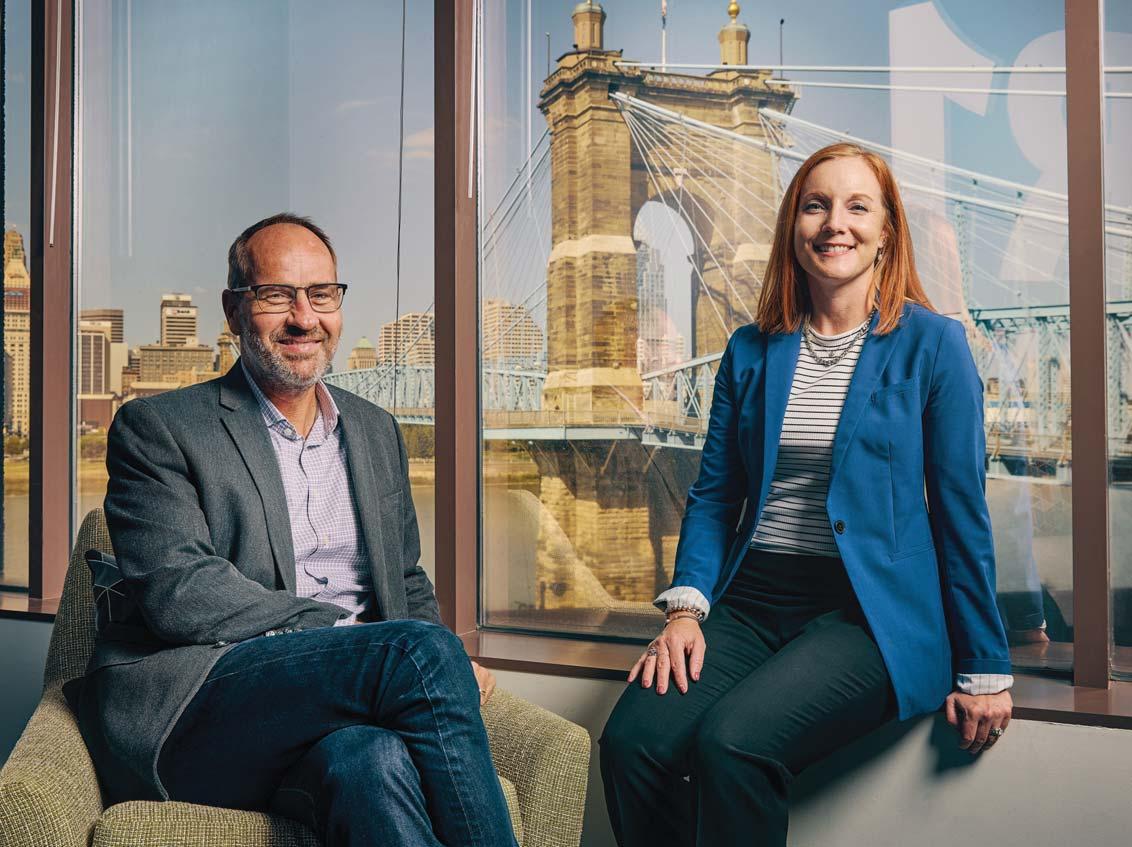
If a new indoor arena makes its way from concept to reality in Cincinnati, there’s a decent chance it will have to break with the naming convention of “Riverfront.” A feasibility study initiated by the Cincinnati Regional Chamber in May identifies a handful of sites that are potentially suited to be the home of a future new Cincinnati arena, and most aren’t along the Ohio River. In fact, a pre-conceived commitment to a riverfront location was not part of the study; its purpose was to perform due diligence in researching and vetting potential sites regardless of locale.
“We’re looking to deliver a common set of facts about what it would take, where are the places in this community it might be best situated, and what’s the opportunity a new arena brings to Cincinnati to attract the types of events and programming we know we’re missing out on today and we know bring economic life,” says Pete Metz, the Chamber’s vice president of civic and regional partnerships. “One thing we all agree on is that tourism lifts Cincinnati.”
The report, made available to the public in early October, includes a set of high-potential sites, with an analysis of each; an analysis of current booking and programming, with benchmarks from peer cities and a potential future state of booking and programming for the new arena; a range of construction costs; and a profit and loss analysis of the new venue. The study is a joint effort among such industry experts as Machete Group, Turner Group, Populous, and MSA Design. The steering committee includes Hamilton County, the city of Cincinnati, Visit Cincy, the Port, the Cincinnati Business Committee, the Cincinnati Regional Business Committee, and 3CDC among its core members.
A NEW FEASIBILITY
ANALYZES THE NEED FOR BUILDING A NEW DOWNTOWN ARENA TO ATTRACT ADDITIONAL EVENTS AND TOURISM DOLLARS. A FEW SITES EMERGED AS FAVORITES.
BY LEYLA SHOKOOHE ILLUSTRATION BY KENZO HAMAZAKI

“We’ve engaged folks around the community who work in the space, work in events and programming, or have an interest in real estate around these areas to make sure we get a clear understanding of the site analysis,” says Metz.
Visit Cincy, the region’s travel and tourism marketing organization, has been a major player in the arena proposal study—not a huge stretch, considering its current board chair is Jeff Berding, co-CEO of FC Cincinnati, second-year co-chair of the Cincinnati Regional Business Committee, and

C“OUR JOB IS TO BRING BIG EVENTS TO THIS REGION, AND YET WE DON’T HAVE THE NECESSARY FACILITIES,” SAYS JEFF BERDING.
a vocal arena proponent.
“Our job is to promote this region and bring big events to this region, and yet we don’t have the necessary facilities,” says Berding, now in his fourth and final year as board chair of Visit Cincy. “The Duke Energy Convention Center was inadequate. The main convention hotel was poor. We tackled those issues as a region, and we now have a wonderful world-class headquarters hotel on its way, and the convention center is undergoing significant improvements, modernization, and site expansion. I felt it was time to tackle the city’s obsolete arena and to ask ourselves as a community, What can we do to address the shortcoming?”
INCINNATI’S EXisting downtown arena, Heritage Bank Center, was built in 1975 as Riverfront Coliseum to complement nearby Riverfront Stadium. As their names implied, they were located on the river and housed a variety of sporting and entertainment events. Home to the minor league Cincinnati Cyclones hockey team, the arena building and its land are owned by Nederlander Entertainment.
The stadium, following several name changes of its own, was torn down to make way for Great American Ball Park after Hamilton County voters decided to fund new stadiums for both the Bengals and the Reds. GAPB now abuts the Heritage Bank Center and shares plaza walkways.
In 2022, the city of Cincinnati put out a request for proposal to redevelop the Town Center Garage on Central Parkway, which is also home to Cincinnati Public Radio (until its move to a new facility in Evanston in 2025) and WCET Channel 48. The site encompasses a total of 147,000 square feet. One of the RFP responses was a proposal by Visit Cincy and Machete Group to examine the site for its suit-
ability as a brand-new arena.
The city decided to take the Town Center site off the redevelopment table earlier this year, and the Cincinnati Chamber took on the responsibility of conducting a full arena feasibility study. Machete, a sports and entertainment facility advisory firm based in Houston, was selected through a competitive RFP process to lead the study.
“We’ve been focused on developing arenas, stadiums, and mixed-use real estate around those facilities,” says Jerry Li, a consultant with Machete Group. “Our bread and butter is really overseeing the development of these types of venues. That’s how we got involved with TQL Stadium as well as the Mercy Health Training Center. The value we add is we come from that world and we know what it takes to operate those buildings and run sports teams, so we provide a unique perspective. We’re not traditional real estate developers.”
Machete has developed facilities for an assortment of sports teams, investors, and entities across the world, with U.S. arenas including the Barclays Center in Brooklyn, the Chase Center in San Francisco, and the Toyota Center in Houston. “We looked at, What are comparable arenas
doing in terms of programming?What is Heritage Bank Center doing right now that a new arena could potentially do in terms of events and what does that mean in terms of profitability?” says Li. “We built out a conceptual financial model to demonstrate what revenue and expenses could potentially look like.”
Heritage Bank Center has undergone a variety of refreshes over the decades to accommodate the needs of a modern venue. But there are only so many retrofits that can happen before the original architecture has to be contended with.
“When Riverfront Coliseum was built, it was a good arena for the time, but that was a different time,” says Bill Baker, managing partner with MSA Design.“Today that building is, at a minimum, about 60 percent of the
total square footage that new arenas are. It should have wider concourses, a bigger back of house, and more loading docks. There’s a whole different customer experience expectation now with premium experiences, club experiences, and seating types from courtside and elevated suites to mid-bowl and bunker clubs. There are premium experiences where the players are walking in through the back tunnel under the floor and that’s a club now. That wasn’t the case in 1975 when the Coliseum was built.”
MSA Design and Populous focused on the design and architectural piece in the feasibility study, suggesting high-level concepts since there isn’t a pre-determined site location. Turner Construction examined building costs, and in addition to provid-

ing oversight Machete Group drilled into the business planning details. The group examined arenas in comparable markets for context, particularly those without major league anchor tenants such as NBA or NHL teams.
“While Heritage Bank Center has served us well over the years, it isn’t on par with the facilities you see in Louisville or Columbus or Cleveland or Kansas City,” says Berding.
“The general public intuitively understands what we’re talking about, because they’re consumers of the games or shows appearing in those buildings and, like me, they sometimes travel to Columbus or Louisville to go to a concert and wonder, Why isn’t that coming to Cincinnati? At the same time, when you talk to business leaders who understand that


A rendering showing the scale of a brandnew arena was part of an initial proposal to build it at Central Parkway and Ezzard Charles Drive.

THE COSTS AND BENEFITS
A steering committee formed by Hamilton County, the city of Cincinnati, the Cincinnati Regional Chamber, Visit Cincy, the Port, the Cincinnati Business Committee, the Cincinnati Regional Business Committee, and 3CDC has released a feasibility study analyzing costs and benefits of a new arena for Cincinnati.
The existing Heritage Bank Center, built in 1975, does not offer the seating capacity and patron amenities of newer facilities in Louisville, Columbus, Cleveland, or Kansas City, and so Cincinnati misses out on hosting a number of high-profile concerts and sporting events.
The study is the first phase in a series of steps to follow should a new arena be deemed feasible. The public has yet to be engaged, and the challenge of identifying funding remains.
major cultural events and major sporting events help drive economic activity—from hotel nights and support for downtown restaurants and small businesses—they see the role an arena plays in that.”
Metz says that Nederlander leadership sent a letter to the original Town Center Garage group saying the company would want the Cyclones to play in a new facility if one were built, which could eliminate the prospect of a new arena competing with the existing Heritage Bank Center. “So we’re operating under the assumption that we have a minor league hockey team as a possible tenant,” he says.
Center occupies a total of about 350,000 square feet. The T-Mobile Center in Kansas City, Missouri, one of the closest to Cincinnati’s scope, encompasses 640,000 square feet.
Nationwide Arena in Columbus is 740,000 square feet. Gainbridge Fieldhouse in Indianapolis is 750,000 square feet.
The city of Kansas City opened T-Mobile Center (originally called Sprint Center) in 2007 without a major-league basketball or hockey tenant. Besides concerts, monster truck shows, and other events, the arena hosts lots of college basketball—from the Big 12 championships to men’s and women’s NCAA tournament rounds to one-off games involving area teams like the University of Kansas. The arena also is home to the National Collegiate Basketball Hall of Fame.
“If we want to capitalize on the assets we have as a city, we need to have an arena that allows us to capture that business,” says Metz. “If you’re Taylor
Swift and you’re bringing a 65,000plus seat concert, we’ve got a stadium venue that works. What we do not have is a venue that works for the Bruce Springsteen arena show or the Childish Gambino concert that’s on tour right now or the two nights of Drake playing in three different Midwestern markets or the Death Cab for Cutie and Postal Service show. Those artists have chosen to book arena tours, and when they do they have a whole set of criteria they use to decide what
“FIVE TO SIX ACRES OF THE RIGHT SHAPE AND SIZE IS IDEAL FOR A NEW ARENA THESE DAYS, AND IT’S GOT TO BE A BIG SQUARE,” SAYS BILL BAKER WITH MSA DESIGN.
venues to book. And right now, too often, we’re not on those tours because we don’t have a venue that can serve their needs.”
The Chamber convened a variety of stakeholders to provide input for the study, scheduling nearly 20 different interviews over the summer, including with Visit Cincy, the Cincinnati Symphony Orchestra, FC Cincinnati, Hard Rock Cafe, Nederlander, the Port, and the Ohio Department of Transportation, among others. “Anybody you could imagine who would have a vested interest in this project, we tried to touch,” says Li. “It became a long process, but I think we got a lot of valuable input, and

we hope that all the stakeholders feel they were heard as part of this initial step of the process.”
The site criteria used in the study covered a gamut of hypotheticals in order to locate the highest potential locales in the region. “We looked at criteria like, How easy or hard would it be to acquire the site? Is the land area big enough to build an arena on it, and how easy is it for pedestrians and vehicles to access it? What amenities and public services are around the arena?” says Metz. “We looked at what is the site’s proximity to the region’s population, how easy or hard would it be for patrons to park, and how easy or hard would it be for them to take public transit. Finally, we studied whether the possible arena locations would catalyze additional off-site development.”
The study team found that the sweet spot for a site size-wise is a landmass of five-plus acres. “Below five, it gets a little tight,” says Baker. “But to six acres of the right shape and size is ideal, though it can’t be just a giant ribbon line. It’s got to be a big
square. That gives you a good idea of a good site that can be made viable.”
The feasibility study looked at 15 sites across the region and narrowed its focus to three or four in the urban core, from the riverfront to Over-theRhine and the West End, with serious potential. The Heritage Bank Center site was one of those original 15.
Happening simultaneously to the study and arena discussion is the reconvening of the Greater Cincinnati Sports Commission, which will be charged with marketing the region to recruit sporting events (such as amateur youth and collegiate events), professional events, music and art shows, trade shows, and more. Berding will serve as chair of the newly formed commission.
“The Sports Commission will go out there and aggressively promote and try to attract those events into our new world-class arena,” he says. “I think the study shows that there’s a significant return on the investment in terms of visitors coming in and spending their dollars in our hotels and restaurants
and in our retail shops, which of course helps grow the local economy and benefits everyone.”
What those benefits are in terms of dollars and cents are not necessarily being determined in this feasibility study. Metz sees the study is the first phase in a series of steps should a new arena be deemed feasible. The public has yet to be engaged, and the challenge of identifying funding remains.
“Ultimately, we’re not the folks who are going to build the arena,” he says. “What we’re trying to do here is create the landscape. There’s been so much conversation about a new arena in this town, but there hasn’t been a shared set of facts for everyone to make informed decisions. One of the first steps is to say, We’ve vetted the business model, vetted where you might put an arena, and vetted what a booking and programming strategy looks like, and here’s what we found. Then we can have a thoughtful conversation and make some decisions.”
The city of Kansas City built T-Mobile Center in 2007 without a major-league basketball or hockey tenant, which is the situation Cincinnati faces as it considers a new downtown arena.
BY JOHN STOWELL
Ariver runs beneath you, unseen and quiet. It begins simply enough as rain falling from the clouds—perhaps a product of a cold front slicing into warm, moist air. Most of it eventually makes its way into the Ohio River or its tributaries. But not all.
Along Ohio’s western spine, the new meets the old as fresh rainwater seeps into the soil and begins its journey through eons of sand, gravel, limestone, and silt before settling into the natural underground wonderland known as the Great Miami Buried Valley Aquifer. And in Hamilton, they lovingly quench their thirst,
proudly proclaiming it “the best water in the world.”
While flavor (or lack of it) is in the taste buds of the beholder, for at least a few businesses it’s an important reason they call Butler County their home. The waters that make up the aquifer are remarkably pure, filtered by up to 250 feet of permeable sediment left behind by glaciers that, three times over the last few million years, covered and retreated from the Miami River Valley.
“The valley was filled with what’s known as glacial outflow, and it was left from the Wisconsin Glacial Stage

which retreated from this area around 24,000 years ago,” says Jonathan Levy, a Miami University associate professor of geology. The glaciers, he notes, retreated and advanced several times before the Ice Age ended—but retreating, he says, just meant the bottom of the glacier was melting faster than the ice was moving.
The material the melting ice deposited became the super-filter that created the aquifer, one of the largest in the U.S. And, because it’s made of porous material, it’s like a giant sponge drenched with water. An estimated 1.5 trillion gallons are stored there, constantly replenished by the Great Miami River, its tributaries, and around 40 inches of rain and snow that fall each year.
Like Levy, Tim McLelland doesn’t lose sleep worrying about Butler County’s water supply drying up. Quality, yes. Quantity, no.
McLelland manages the Groundwater Consortium of area cities, water companies, and businesses. Since 1991, the group has pooled resources to monitor the aquifer and protect it from contamination. McClelland, who counts consumer education as an important role the consortium plays, has led the group for nearly 25 years.
The aquifer originates in Indian Lake halfway between Bellefontaine and Wapakoneta. That’s where the Great Miami River emerges from the southern end of the Logan County reservoir and begins its 160-mile journey south to the Ohio River. The aquifer runs underneath and two to three miles on either side of the river and, according to the Miami Conservancy District, provides drinking water for 2.3 million people in southwest Ohio. While most of the customers are further north, Levy notes, 12 percent of Cincinnati’s water is supplied by the aquifer. (The remaining drinking water is pulled from the Ohio River.)
“Developers come to me all the time and ask Where does it end? when they’re trying to deal with building foundations on a pile of sand,” McClelland says, laughing. “I tell them it doesn’t.”
quality helped attract the MolsonCoors brewery to northern Butler County, where it employs nearly 500 workers and produces more than 10 million barrels a year of Miller Lite, Coors Light, Miller High Life, and a dozen or so other beer brands. The Trenton brewery also produces all of the company’s canned aquifer water, which is distributed as aid to communities suffering from emergencies or natural disasters.
The water attracts small brewers, too. “We are one of the few breweries in this area that doesn’t treat our water at all with any extra minerals,” says Jim Goodman, co-founder of Hamilton’s Municipal Brew Works, who explains he simply filters out the fluoride and chlorine that the municipal water company puts in. “We don’t have to. It’s that good. I like to refer to it as the Goldilocks of water—not too hard, not too soft. So it works with all styles of beer.”
Jody Gunderson, Hamilton’s economic development director, says the city’s electric, gas, and water utilities are big selling points when recruiting new businesses.

Goodman is fresh off a big win for Municipal with its scotch ale, Guthrie, taking a gold medal at the U.S. Open Beer Championships. He’s also busy preparing to brew a special blueberry hefeweizen in collaboration with five other breweries. Goodman says he likes to experiment, but not with the water. He talks about all the variables that can make or break a beer. Was the barley roasted properly? Is the malt too sugary? Were the hops picked too early? Was it a wet summer or was it too dry? “But we never worry about the water,” he says. “It’s consistently good, which is why we always test it but never treat it.”
Municipal brews about 1,000 barrels of beer a year, which translates to approximately 31,000 gallons of water used. Contrast that to MolsonCoors, which its website says produces 10.4 million barrels of beer a year out of the Trenton plant. That translates to approximately 322 million gallons of aquifer water annually, making it the aquifer’s biggest commercial customer. The company maintains three private wells on its property.
Like all the wells that serve Hamilton, Fairfield, Dayton, and surrounding communities, the MolsonCoors water portals are dependable workhorses, McLelland notes. Even when a severe drought hit the region in 2007, the aquifer level registered only about a three-foot drop from its typical 250-foot depth.
the aquifer means McLelland relies a lot on cooperation from business, industry, and government. He achieves results primarily by persuasion since laws and
regulations designed to protect the water quality appear to be as porous as the soil.
In late August, McLelland participated in a table-top emergency response exercise with the Mid-Valley Oil Pipeline Company. The Texas firm owns an oil pipeline that crosses Seven Mile Creek near its confluence with the Great Miami River. Its 20inch main, carrying 10,000 barrels of pumped crude, had recently popped out of the riverbed and had been struck by a falling tree. Fortunately, the pipe held.
CONTAMINATED SECTIONS OF THE AQUIFER ARE KEPT ISOLATED FROM THE REST, ESPECIALLY UNDER THE FORMER FERNALD AND CHEM-DYNE PROPERTIES.
quired by law to do so. He credits the company with practicing good corporate stewardship and says the tabletop emergency exercise simulating an even worse calamity will make future emergency responses more effective.
While the ecosystem was untouched by the oil pipeline, there are sections of the aquifer that remain isolated because, in the past, they were contaminated. Probably the most recognizable of these was the Fernald Materials Processing Center, which from 1951 to 1989 processed uranium for the U.S. defense industry on the Hamilton/Butler county line. The Superfund site has largely been restored—it’s now a nature preserve—but pumps continue to extract uranium from several remediation wells located around the property.
Similarly, the groundwater lying below the infamous Chem-Dyne property near downtown Hamilton, another nationally known Superfund site, is polluted with chemicals, pesticides, PCBs, and waste oil.
he says, but he’s watching it closely along with the Ohio Environmental Protection Agency.
“The biggest threat from PFAS or any other contamination comes in the more shallow parts of the aquifer where there’s less an opportunity for dilution,” McLelland says, noting that the forever chemicals are everywhere. “It’s in our wax paper, our pizza boxes, our popcorn bags, and it’s going to be very expensive to deal with.”
“If it hadn’t, that oil would have been in the Great Miami within two hours,” McLelland says, noting that the incident happened around the time of the East Palestine train disaster. The city of Hamilton’s prized drinking water would have been the spill’s first victim.
“It would have been a long-term and expensive cleanup but, even more difficult, especially after East Palestine, it would have been difficult convincing our customers that the water’s safe to drink. That would been a question on their minds forever.”
Mid-Valley reburied the pipeline, although McLelland ruefully noted that executives said they weren’t re-
“It’s probably contaminated forever, and we’ll likely never be able to use that part of the aquifer again,” says McLelland. Like the Fernald groundwater, it’s been isolated from the rest of aquifer and water is pumped out, treated with a variety of technologies and natural processes, and returned.
Other threats to the aquifer include pesticide and fertilizer runoff, leaking oil and gas tanks, contaminated runoff from urban streetscapes, and perfluoroalkyls, commonly known as PFASs (or “forever chemicals”). Most of those, McLelland notes, leach from landfills. It’s not a serious problem in the aquifer yet,
es aside, Hamilton knows what it has. The city bottles the “best tasting water in the world” in stout blue plastic bottles and sells it on the retail market. It’s right out of the tap, and they’re not afraid to say so. On the back of the bottle, the label proudly proclaims the beverage’s source water is the Great Miami Buried Valley Aquifer, while its front label blandly describes it as coming “from a municipal source.” When you want to refill it, the city brags, just turn on your kitchen faucet. After all, the product is called Hamilton on Tap.
“I came here from Minneapolis, where they’re very proud of their water quality, but I remember telling my boys when we moved here that we didn’t need to buy bottled water any longer,” says Jody Gunderson, Hamilton’s economic development director. “The stuff coming out of the tap? It’s better.”
Gunderson, who has entertained some brushing inquiries from the nation’s big water bottlers—he wouldn’t specify which ones—says Hamilton’s electric, gas, and water utilities are big selling points for bringing new business to the city. “I always emphasize our water quality with every
proposal, whether they ask for it or not. It’s a unique selling point, and it could be a tiebreaker.”
The region’s water quality is widely known to prospective customers, he says, and he predicts they’ll continue to receive inquiries going forward. He just landed the city’s first data center—a $15-million investment set to open next year—and notes that it’s a water-intensive industry. A flavoring company in the city’s industrial park is also water-dependent. “Going forward, I’m able to be a little more judicious in the kinds of companies we seek because they really want to be consumers of our utilities,” Gunderson says. “It’s a
good place to be.”
A couple of blocks from Gunderson’s municipal building office, two former Procter & Gamble entrepreneurs saw an opportunity and took it. Ice Mountain, Desani, or Aquafina may not call Hamilton home, but Pahhani Premium Alkaline water does.
Co-owners Satinder Bharaj and Erik Loomis watch as their dispenser pumps out 100 bottles of water a minute, twice a week, directly from the city’s water system. They produce around 14,000 bottles a week, which they sell mostly in convenience stores, natural food groceries, and health clubs.
“We start with this water, which has been recognized as the best in the world,” says Bharaj, who has a Ph.D. in pharmaceutical science and undergraduate degrees in biology and chemistry. “That’s not puffery. It’s a two-time gold medal winner at Berkeley Springs International Water Tasting Competition, the Olympic Games of water.”
Loomis, with degrees in environmental science and business administration, says the key to Pahhani water is its alkalinity—a pH greater than 8 that comes courtesy of the aquifer’s limestone-based natural filter. “We pride ourselves in being a single source,” he says, “and we use a natural
TASTES GREAT Municipal Brew Works is among a number of Butler County businesses that depend on high-quality public water.

ONE BIG SPONGE
The Great Miami Buried Valley Aquifer holds an estimated 1.5 trillion gallons of limestone-filtered water under the Great Miami River, which Hamilton city officials and business owners say produces “the best water in the world.”
JUST RIGHT
Water-intensive industrial customers such as MolsonCoors and Municipal Brew Works use the water right out of the ground or tap. “It’s the Goldilocks of water—not too hard, not too soft,” says Jim Goodman, Municipal’s co-founder.
TREATING THE PROBLEMS
Sections of the aquifer around two area Superfund cleanup sites, the former Fernald and Chem-Dyne factories, are segregated from the rest of the aquifer and water is continuously pumped out from those locations, treated, and returned.
process versus the artificial processes that other bottled waters use.”
It’s not to say Pahhani doesn’t treat the water that comes out of the tap. The company has a proprietary process, Loomis says, that perpetuates a taste difference that, he laughs, “has water snobs coming up to us and saying they won’t go back to their old water.” Their process, he says, also slightly increases the water’s alkalinity, improving its absorption into the body.
The city of Hamilton treats its water, too, with a mixture of chlorine gas and sodium chlorite to chemically create chlorine dioxide. It’s a unique and complex process designed to eliminate
chlorine smell and taste. It’s all done on site because chlorine dioxide can’t be transported on public roads.
The result is a hard water filtered by sediments dropped before dinosaurs roamed Earth, uniquely treated (and sometimes untreated if you’re a craft brewer), bottled in sturdy plastic blue bottles, commercialized by businesses large and small, and celebrated by water connoisseurs for its hydrating qualities and feel on the tongue and palate. It’s the foundation for hundreds of jobs and a clear marketing advantage for Hamilton, Fairfield, and the other communities that draw Heaven’s liquid from the river beneath.
Pahhni co-owners
Satinder Bharaj (right) and Erik Loomis are exP&Gers who use aquifer water as the base for their high-alkaline bottled water, producing around 14,000 bottles a week.











PRESIDENT AND CEO
WARSAW FEDERAL
ASK ME ABOUT How Warsaw Federal’s designation as a Minority Deposit Institution impacts its home neighborhoods.
ASK ME ABOUT How the company’s success in placemaking led to its second location in Oklahoma City.
HOW HAS THE BANK IMPACTED PRICE HILL AND SAYLER PARK SPECIFICALLY?
For 130 years, Warsaw Federal has proudly supported these two
WHAT IS WARSAW FEDERAL’S MISSION AS AN MDI? Warsaw is a mutual bank, which means we’re in the best position to make decisions that benefit customers and communities, not shareholders. We invest 100 percent of our deposit dollars locally. We know that people of color and those community members in the low- to moderate-income space have been grossly underserved, and so putting an organization in place to support their needs is particularly important.
neighborhoods. We received our MDI designation late last year. We’re taking a measured and thoughtful approach in our transition to an MDI by designing our offerings alongside our community members so we can deliver an impactful experience.
HOW DO YOU MEET THE UNIQUE NEEDS OF YOUR COMMUNITY?
We conduct community listening sessions to understand the needs and concerns of our customers and community. We want to provide focused financial solutions, tools, and education and meet community members, customers, and small businesses where they are, including partnering with local nonprofits and community
organizations. We recently launched a new online and mobile platform to help customers bank wherever they are and whenever they want. It has several terrific features that help with budgeting, credit scores, and more.
–ELIZABETH MILLER WOOD
HOW HAS METRONOW! PERFORMANCE COMPARED WITH ORIGINAL PROJECTIONS? MetroNow! has exceeded its ridership projections, providing more than 62,000 trips. Almost immediately, feedback indicated a strong desire to expand. In response, we’ve extended the pilot zone areas and service hours to better meet rider needs. We plan to introduce additional zones and explore partnerships with businesses and organizations to further develop the service.
WHAT IS THE NEXT STEP IN GETTING THE BUS RAPID TRANSIT (BRT) CORRIDORS RUNNING? The vision is to provide a high-quality, bus-based travel option that combines the speed, efficiency, and comfort of rail transit with the flexibility of traditional bus service. The BRT project is in its design and

environmental phase, and we’ve kicked off a robust public engagement campaign to continue to identify what the community needs are. The timetable for the project is on track, and we’ll look to see construction begin in 2026, the Reading Road corridor to launch in 2027, and the Hamilton Avenue corridor to launch in 2028.
HOW DO THESE INITIATIVES ENCOURAGE EQUITY IN GREATER CINCINNATI? Transit is about providing an opportunity, and the Reinventing Metro plan has addressed issues of connectivity to jobs and essential services. We’ve been intentional about making MetroNow! affordable and accessible. The service is only $2. We have also provided the option to call for a ride. The $300-million BRT project creates access to 225,000 job opportunities through 24-hour service regardless of where they live. –E.M.W.
WHY WAS OKLAHOMA CITY CHOSEN FOR YARD & CO.’S SECOND LOCATION? I’m originally from that part of the country, but, most importantly, it meets our growth plans for the Midwest, South, and Southwest.
WHAT TYPES OF UNDERUSED SPACES ARE MOST RIPE FOR PLACEMAKING PROJECTS AND FOR ECONOMIC DEVELOPMENT? We believe all places should
CHIEF STRATEGIC PLANNING, DEVELOPMENT, AND INNOVATION OFFICER
SOUTHWEST OHIO REGIONAL TRANSIT AUTHORITY (SORTA)
ASK ME ABOUT The MetroNow! program’s first year and next steps in the Bus Rapid Transit initiative.
dream big and have robust ambitions for how they can grow, but we also believe the way to get there is to start small. We love spaces that are tucked away, slightly hidden, physically unique in some way and feel crowded with just a few dozen people. Often these places feel like outdoor rooms or comfortable backyards. Once you find the right space, you can decide what goes in it.
What’s missing from your neighborhood? What do you want? Once you answer that, then do a pop-up event in the space.
WHAT ETHICAL FACTORS ARE CONSIDERED WHEN DEVELOPING UNDERUSED URBAN SPACES? Whenever possible, we create processes where residents are the leaders and the builders. This inherently makes the places and spaces
feel more inclusive and better connects the outcomes to the quality of life and priorities that residents have outlined for their neighborhoods. It also creates ownership and optimism around what else can be changed by getting involved and staying involved.–E.M.W.







PHOTOGRAPHS
BY
RHINE MEDIA







Zinzinnati toasted its 48th Oktoberfest in a new location, with plenty of space, sights, and shade to go around. – JOHN FOX





Oktoberfest Zinzinnati launched in 1976 and has grown tremendously over the years and across various locations. Organized by the Cincinnati Regional Chamber, it’s now considered the largest Oktoberfest in the U.S. and the world’s second largest after Munich, Germany.
The riverfront stretch between Sawyer Point and Yeatman’s Cove offered a different experience this year as compared to recent years on downtown streets. Crowds enjoyed the trees, grass, river views, seating areas, and fest tents scattered throughout the event footprint. Lots of traditions endured, from weiner dog races to chicken dances.
Oktoberfest hosted 20 beer vendors, 10 of which were local breweries (plus Sam Adams). The festival ordered 628 kegs of German beer ahead of time from authentic German brands such as Radeberger, Erdinger, Spaten, Weihenstephaner, Warsteiner, and Krombacher.





More than 30 food vendors kept the masses fed, from ubiquitous sausage options and strudel to limburger cheese sandwiches and goetta pizza. There was also a food truck row near the main Festhalle tent.
Speaking of the largest tent in Oktoberfest Zinzinnati history, the 18,000-square-foot Festhalle tent at Yateman’s Cove was a festival centerpiece. A total of 51 live performances (plus circus acts and a speed-dating event) were held on the main stage there and five other stages scattered along the riverfront.





$75 million Operations Spending Impact
$10.3 million Student Spending Impact
$571.9 million Alumni Impact
$657.2 million Total Impact
10,303 Jobs Supported
For every dollar spent on training employees at Cincinnati State’s WDC, businesses receive a $33 ROI.
85% of Cincinnati State’s alumni remain in the regional economy.
Cincinnati State and its students support one out of every 134 jobs in the area.
Cincinnati State has been a part of every economic recovery in our region for over 50 years and will continue to lead workforce development through exceptional real-world, hands-on learning, quality transfer education and technical training.
Start by accelerating the potential of your employees through our Workforce Development Center. Contact Amy Waldbillig, Vice President, Workforce Development at (513)569-1643 or amy.waldbillig@ cincinnatistate.edu.
cincinnatistate.edu












Invest in Strong Communicators




The Howe Writing Center is Miami’s No. 1 resource for students to sharpen their communication skills and become effective writers. Working with our well-trained peer-consultants prepares them for the real world and provides them with skills that make them critical assets for any workplace. When you hire Miami graduates, you’re bringing on talent that knows how to collaborate with peers, create impactful messaging, and elevate your business communication.





